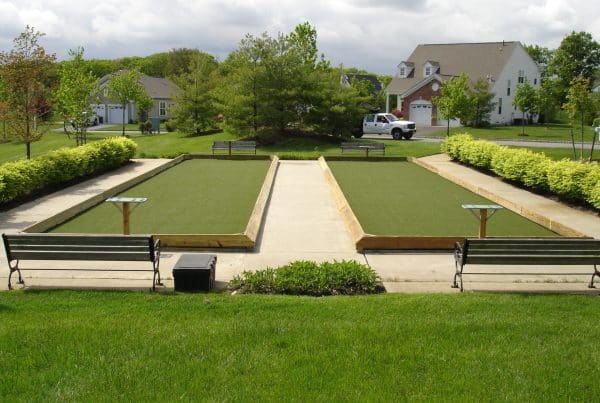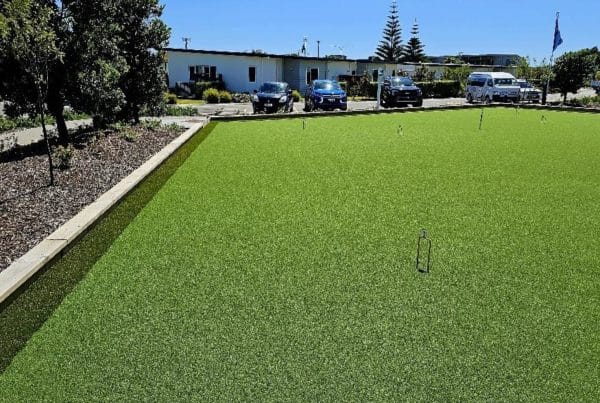At Unreal Lawns & Courts, we’ve witnessed a remarkable transformation in artificial grass textures over the years. Gone are the days of plastic-looking turf that felt unnatural underfoot.
Today’s artificial grass boasts realistic textures that mimic the look and feel of natural grass with stunning accuracy. From multi-toned blades to soft, pliable fibres, these advancements have revolutionised the way we experience synthetic lawns.
How Artificial Grass Has Evolved
From Plastic to Perfection
The evolution of artificial grass stands as a testament to technological innovation and consumer demand for realistic alternatives to natural lawns. In the 1960s, artificial turf emerged as a stiff, plastic-like surface that barely resembled real grass. These early versions (often criticised for their unnatural appearance) failed to replicate the look or feel of natural lawns.
Technological Breakthroughs
Manufacturing techniques advanced rapidly, propelling the quality of artificial grass forward. The 1990s introduced polyethylene fibres, a game-changing development. These fibres allowed for softer, more pliable blades that felt natural underfoot. The texture improved dramatically, moving away from the carpet-like feel of earlier versions.

Multi-Fibre Innovation
One of the most impactful developments in artificial grass technology has been the incorporation of multiple yarn types and colours. Manufacturers are incorporating multi-colour yarns to achieve added realism. This technology allows blending yellow thatching fibres with green grass blades, creating products that closely mimic the varied textures and hues of natural grass.
Colour Revolution
The colour palette of artificial grass has expanded significantly. Modern artificial turf often incorporates several shades of green (and sometimes even hints of brown or yellow) to create a more authentic look. This multi-tonal approach eliminates the uniform, “too perfect” appearance that was a telltale sign of older artificial grass products. Some artificial grass comes in various yarn colours to promote realism and includes UV stabilisation to keep fading at bay.
Texture and Comfort
Today’s artificial grass boasts realistic textures that mimic the look and feel of natural grass with stunning accuracy. From multi-toned blades to soft, pliable fibres, these advancements have revolutionised the way we experience synthetic lawns. The result? Artificial grass that’s nearly indistinguishable from the real thing, providing all the benefits of a low-maintenance lawn without sacrificing aesthetics or comfort.
As we move forward, the next chapter will explore the specific features that make modern artificial grass textures so realistic and appealing to homeowners and businesses alike.
How Modern Artificial Grass Mimics Nature
Modern artificial grass has revolutionised the synthetic turf industry with its ability to replicate the look and feel of natural lawns. The latest advancements in technology have produced products that closely mimic the lushness and feel of natural grass, both visually and tactilely.
Thatch Layers Add Depth and Realism
A key feature that sets modern artificial grass apart is the inclusion of thatch layers. These layers consist of shorter, curled fibres that sit at the base of the longer grass blades. This design mimics the natural build-up of dead grass and roots found in real lawns, adding depth and a more organic appearance to the turf.
Thatch layers not only enhance the visual realism but also provide practical benefits. They support the longer blades, keeping them upright and preventing matting (a common issue in older artificial grass products). This feature proves particularly important in high-traffic areas, ensuring the grass maintains its natural look even under heavy use.

Multi-Toned Blades Create Natural Variation
Modern synthetic turf incorporates multiple shades of green (and sometimes even brown or yellow) to replicate the natural variations found in real grass. This multi-tonal approach creates a more authentic look, eliminating the “too perfect” appearance that was a telltale sign of older artificial grass products.
Advanced manufacturing processes blend different coloured yarns to achieve these colour variations. Some products might combine lime green, olive green, and forest green fibres to create a rich, varied palette that changes subtly depending on the angle of view or the light conditions.
Soft, Pliable Fibres Enhance Comfort
The texture of the fibres themselves marks perhaps the most significant improvement in modern artificial grass. Today’s synthetic grass blades feel soft and pliable, a stark contrast to the stiff, plastic-like feel of early artificial turf.
These softer fibres closely mimic the texture of natural grass. The result is a surface that feels comfortable underfoot, making it ideal for barefoot activities, children’s play areas, and pet zones.
As we explore the benefits of these realistic textures in the next section, you’ll see how these advancements have transformed artificial grass from a mere alternative to a preferred choice for many homeowners and businesses.
Why Realistic Artificial Grass Textures Matter
Elevating Property Aesthetics
Realistic artificial grass textures transform synthetic lawns from a mere alternative to a preferred choice for many property owners. These advancements offer significant benefits that extend beyond aesthetics, impacting comfort, durability, and overall user experience.
The realistic textures of modern artificial grass significantly enhance the visual appeal of both residential and commercial spaces. A major draw of artificial grass is its consistent, year-round aesthetic appeal. Natural grass can be challenging to maintain, often browning during dry spells, while artificial grass maintains its vibrant look regardless of weather conditions or foot traffic, ensuring a professional appearance year-round.
For commercial spaces (such as hotels or office complexes), the consistent, lush appearance of realistic artificial grass creates a positive first impression for visitors and clients.
Comfort and Usability
The soft, pliable fibres of modern artificial grass have dramatically improved its comfort level. This enhanced texture makes it ideal for a variety of uses that were previously challenging with older synthetic turf versions.
For barefoot activities, the gentle texture of today’s artificial grass provides a comfortable surface that feels natural underfoot. This makes it perfect for backyard relaxation, yoga sessions, or children’s play areas.
Pet owners also benefit from these advancements. The realistic textures are gentler on paws and more inviting for pets to use, addressing a common concern with earlier artificial grass products. Additionally, the improved drainage systems in modern turf help manage pet waste more effectively, maintaining a clean and odour-free environment.

Longevity and Cost-Effectiveness
The realistic textures of modern artificial grass contribute significantly to its durability and longevity. The multi-fibre construction and advanced manufacturing techniques result in a more resilient product that can withstand heavy use without losing its shape or appearance.
According to industry data, high-quality artificial grass can last up to 15-20 years with proper care. This longevity, combined with minimal maintenance requirements, makes it a cost-effective solution in the long run. Property owners can save on water bills, lawn care equipment, and labour costs associated with natural grass maintenance.
The benefits of realistic artificial grass textures extend far beyond mere appearance. They have revolutionised the way we think about and use outdoor spaces, offering practical advantages that make them an increasingly popular choice for both residential and commercial applications (including sports fields, playgrounds, and public spaces).
Final Thoughts
The evolution of artificial grass textures has transformed synthetic lawns from a functional alternative to a preferred choice for many property owners. Modern artificial grass now boasts multi-toned blades, thatch layers, and varied fibre types that closely mimic the look and feel of natural grass. This realism extends beyond mere aesthetics, creating outdoor spaces that are inviting, pet-friendly, and suitable for a wide range of applications.
The future of artificial grass technology and textures appears bright. We anticipate further innovations in fibre materials, manufacturing techniques, and colour variations that will push the boundaries of realism even further. As environmental concerns grow, we also expect to see advancements in eco-friendly production methods and increased recyclability of artificial grass products.
At Unreal Lawns & Courts, we commit to staying at the forefront of these developments, offering our customers the latest in artificial grass technology. Our premium synthetic turf solutions combine cutting-edge textures with durability and low maintenance, providing beautiful, hassle-free outdoor spaces for homes and businesses across New Zealand. We look forward to bringing even more innovative and realistic artificial grass texture options to our customers in the future.





